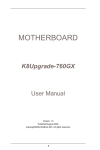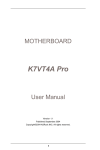Download Asrock K8 combo-z
Transcript
MOTHERBOARD K8 Combo-Z User Manual Version 1.0 Published July 2004 Copyright©2004 ASRock INC. All rights reserved. 1 Copyright Notice: No part of this manual may be reproduced, transcribed, transmitted, or translated in any language, in any form or by any means, except duplication of documentation by the purchaser for backup purpose, without written consent of ASRock Inc. Products and corporate names appearing in this manual may or may not be registered trademarks or copyrights of their respective companies, and are used only for identification or explanation and to the owners’ benefit, without intent to infringe. Disclaimer: Specifications and information contained in this manual are furnished for informational use only and subject to change without notice, and should not be constructed as a commitment by ASRock. ASRock assumes no responsibility for any errors or omissions that may appear in this manual. With respect to the contents of this manual, ASRock does not provide warranty of any kind, either expressed or implied, including but not limited to the implied warranties or conditions of merchantability or fitness for a particular purpose. In no event shall ASRock, its directors, officers, employees, or agents be liable for any indirect, special, incidental, or consequential damages (including damages for loss of profits, loss of business, loss of data, interruption of business and the like), even if ASRock has been advised of the possibility of such damages arising from any defect or error in the manual or product. This device complies with Part 15 of the FCC Rules. Operation is subject to the following two conditions: (1) this device may not cause harmful interference, and (2) this device must accept any interference received, including interference that may cause undesired operation. ASRock Website: http://www.asrock.com 2 Contents 1. Introduction ....................................................... 5 1.1 1.2 1.3 1.4 Package Contents ............................................................... Specifications ..................................................................... Motherboard Layout ........................................................... ASRock 8CH I/O .................................................................. 5 6 9 10 2. Installation ......................................................... 11 Pre-installation Precautions ......................................................... 2.1 CPU Sockets ....................................................................... 2.2 CPU Installation ................................................................... 2.3 Installation of CPU Fan and Heatsink ................................. 2.4 Installation of Memory Modules (DIMM) .............................. 2.5 Expansion Slots (PCI Express X1, PCI and AGP Slots) ..... 2.6 Jumpers Setup .................................................................... 2.7 Onboard Headers and Connectors .................................... 2.8 Serial ATA (SATA) Hard Disks Installation .......................... 2.9 Making An SATA Driver Diskette ......................................... 11 12 13 13 14 16 17 18 21 21 3. BIOS SETUP UTILITY .............................................. 22 3.1 3.2 3.3 3.4 3.5 3.6 3.7 Introduction ......................................................................... 3.1.1 BIOS Menu Bar ......................................................... 3.1.2 Navigation Keys ....................................................... Main Screen ........................................................................ Advanced Screen .............................................................. 3.3.1 CPU Configuration .................................................... 3.3.2 Chipset Configuration ............................................... 3.3.3 ACPI Configuration ................................................... 3.3.4 IDE Configuration ...................................................... 3.3.5 PCIPnP Configuration ................................................ 3.3.6 Floppy Configuration ................................................ 3.3.7 Super IO Configuration ............................................. 3.3.8 USB Configuration .................................................... Hardware Health Event Monitoring Screen ....................... Boot Screen ........................................................................ 3.5.1 Boot Settings Configuration ..................................... 3.5.2 Boot Device Priority .................................................. Security Screen .................................................................. Exit Screen ......................................................................... 3 22 22 23 23 24 24 27 28 29 31 31 32 33 34 34 35 35 36 37 4. Software Support ................................................... 38 4.1 4.2 Install Operating System ........................................................... Support CD Information ............................................................. 4.2.1 Running Support CD ....................................................... 4.2.2 Drivers Menu .................................................................. 4.2.3 Utilities Menu ................................................................... 38 38 38 38 38 APPENDIX: AMD’s Cool ‘n’ Quiet TM Technology ...... 39 4 1. Introduction Thank you for purchasing ASRock K8 Combo-Z motherboard, a reliable motherboard produced under ASRock’s consistently stringent quality control. It delivers excellent performance with robust design conforming to ASRock’s commitment to quality and endurance. In this manual, chapter 1 and 2 contain introduction of the motherboard and step-bystep guide to the hardware installation. Chapter 3 and 4 contain the configuration guide to BIOS setup and information of the Support CD. Because the motherboard specifications and the BIOS software might be updated, the content of this manual will be subject to change without notice. In case any modifications of this manual occur, the updated version will be available on ASRock website without further notice. You may find the latest memory and CPU support lists on ASRock website as well. ASRock website 1.1 http://www.asrock.com Package Contents 1 x ASRock K8 Combo-Z Motherboard (ATX Form Factor: 12.0-in x 9.6-in, 30.5 cm x 24.4 cm) 1 x ASRock K8 Combo-Z Quick Installation Guide 1 x ASRock K8 Combo-Z Support CD 1 x Ultra ATA 66/100/133 IDE Ribbon Cable (80-conductor) 1 x 3.5-in Floppy Drive Ribbon Cable 1 x Serial ATA (SATA) Data Cable 1 x Serial ATA (SATA) HDD Power Cable (Optional) 1 x ASRock 8CH I/O Shield 5 1.2 Specifications Platform: CPU: ATX Form Factor: 12.0-in x 9.6-in, 30.5 cm x 24.4 cm 1. 939-Pin Socket Supporting AMD AthlonTM 64FX Processor 2. 754-Pin Socket Supporting advanced 64-bit AMD AthlonTM 64 and 32-bit Sempron Processor (see CAUTION 1) Supports AMD’s Cool ‘n’ QuietTM Technology (see CAUTION 2) Chipsets: Bridge: ALi M1689 Chipset 1. For 939-Pin CPU, FSB @ 1 GHz / 2.0 GT/s 2. For 754-Pin CPU, FSB @ 800 MHz / 1.6 GT/s Memory: 1. For 939-Pin CPU: 3 x DDR DIMM Slots: DDR1, DDR2, and DDR3 2 DIMMs Support PC3200 (DDR400) / PC2700 (DDR333) / PC2100 (DDR266), Max. 2GB (see CAUTION 3) Dual Channel Memory Technology Support (see CAUTION 4) 2. For 754-Pin CPU: 2 x DDR DIMM Slots: DDR4 and DDR5 Support PC3200 (DDR400) / PC2700 (DDR333) / PC2100 (DDR266), Max. 2GB NO SUPPORT for Dual Channel Memory Technology IDE: IDE1: ATA 133 / Ultra DMA Mode 6 IDE2: ATA 133 / Ultra DMA Mode 6 Supports up to 4 IDE Devices Serial ATA: 2 x SATA Connectors Supports up to 2 SATA Devices at 1.5Gb/s Data Transfer Rate Floppy Port: Supports up to 2 Floppy Disk Drives Audio: Superior 7.1-channel Audio with Ultimate 3D Surround Sound Effect for Stereo Media LAN: Speed: 802.3u (10/100 Ethernet), Supports Wake-On-LAN Hardware Monitor: CPU Temperature Sensing Motherboard Temperature Sensing CPU Overheat Shutdown to Protect CPU Life (ASRock U-COP)(see CAUTION 5) CPU Fan Tachometer Chassis Fan Tachometer Voltage Monitoring: +12V, +5V, +3.3V, Vcore PCI Slots: 3 x PCI Slots, PCI Specification 2.2 AGP slot: 1 x AGP Slot Supports 1.5V, 8X / 4X AGP Card (see CAUTION 6) 6 USB 2.0: ASRock 8CH I/O: BIOS: OS: 8 USB 2.0 Ports: 4 Ready-to-Use USB 2.0 Ports on the I/O Panel Plus 2 On-Board Headers Supporting 4 Extra USB 2.0 Ports (see CAUTION 7) 1 PS/2 Mouse Port, 1 PS/2 Keyboard Port 1 Serial Port: COM1 1 Parallel Port (ECP/EPP Support) 4 Ready-to-Use USB 2.0 Ports 1 RJ-45 Port Audio Jack: Side Speaker / Rear Speaker / Central/Bass / Line In / Front Speaker / Microphone (see CAUTION 8) AMI Legal BIOS Supports “Plug and Play” ACPI 1.1 Compliance Wake Up Events SMBIOS 2.3.1 Support CPU Frequency Stepless Control (only for advanced users’ reference, see CAUTION 9) Microsoft® Windows® 98 SE / ME / 2000 / XP compliant 7 CAUTION! 1. This motherboard is equipped with two types of CPU sockets. You may choose to install either AMD 939-Pin CPU or AMD 754-Pin CPU into this motherboard. However, to avoid instability and damage to the system, please do not install both of them into this motherboard. 2. For power-saving sake, it is strongly recommended to enable AMD’s Cool ‘n’ QuietTM technology under Windows system. See APPENDIX on page 39 to 3. enable AMD’s Cool ‘n’ QuietTM technology. If you install a 939-Pin CPU into this motherboard, please refer to page 14 for 4. proper installation of memory modules on DDR1, DDR2, and DDR3. If you install a 939-Pin CPU into this motherboard, it will support Dual Channel Memory Technology. Before you implement Dual Channel Memory Technology, make sure to read the installation guide of memory modules on page 14 for 5. proper installation. While CPU overheat is detected, the system will automatically shutdown. Before you resume the system, please check if the CPU fan on the motherboard functions properly and unplug the power cord, then plug it back again. To improve heat dissipation, remember to spray thermal grease between the CPU and the heatsink when you install the PC system. 6. Do NOT use a 3.3V AGP card on the AGP slot of this motherboard! It may cause permanent damage! 7. Power Management for USB 2.0 works fine under Microsoft® Windows ® XP SP1 / 2000 SP4. It may not work properly under Microsoft® Windows® 98/ ME. Please refer to Microsoft® official document at http://www.microsoft.com/whdc/hwdev/bus/USB/USB2support.mspx 8. 9. For microphone input, this motherboard supports both stereo and mono modes. For audio output, this motherboard supports 2-channel, 4-channel, 6-channel, and 8-channel modes. Please check the table on page 10 for proper connection. Although this motherboard offers stepless control, it is not recommended to perform over-clocking. Frequencies other than the recommended CPU bus frequencies may cause the instability of the system or damage the CPU. 8 1.3 Motherboard Layout 1 2 4 3 24.4cm (9.6 in) PS2_USB_PWR1 1 PS2 Mouse DDR5 (64/72 bit, 184-pin module) ATXPWR1 COM1 PARALLEL PORT PS2 Keyboard 5 DDR4 (64/72 bit, 184-pin module) K8_754: FSB800 6 ATX12V1 USB 2.0 T: USB2 B: USB3 Socket 754 Top: REAR SPK Center: FRONT Top: LINE IN Bottom: MIC IN Center: SIDE SPK Bottom: CTR BASS 33 K8_939:FSB1G Top: RJ-45 1 1 SOCKET 939 USB 2.0 T: USB0 B: USB1 8 K8 Combo -Z J7 1 J5 J6 CPU_FAN1 32 31 J1 1 1 1 1 1 1 1 1 1 1 DDR1 (64/72 bit, 184-pin module) LAN PHY DDR2 (64/72 bit, 184-pin module) J2 1 1 1 1 1 1 1 1 1 1 J3 J4 1 1 1 1 1 1 1 1 1 1 10 AGP8X IR1 11 1 1.5V_AGP1 ATA133 Super I/O IDE1 PCI1 7.1 CH 29 PCI2 AUDIO CODEC JL1 4 5 6 7 8 9 10 11 12 13 14 15 16 NB_FAN1 1 1 25 24 PS2_USB_PWR1 Jumper ATX Power Connector (ATXPWR1) CPU Heatsink Retention Module (for 939-Pin CPU) 939-Pin CPU Socket 184-pin DDR DIMM Slots (DDR4- 5, for 754-Pin CPU only) CPU Heatsink Retention Module (for 754-Pin CPU) 754-Pin CPU Socket J7 Jumper CPU Fan Connector (CPU_FAN1) J1 / J2 / J3 / J4 Jumpers AGP Slot (1.5V_AGP1) Primary IDE Connector (IDE1, Blue) Secondary IDE Connector (IDE2, Black) Clear CMOS Jumper (CLRTC1) Chassis Fan Connector (CHA_FAN1) Bridge Fan Connector (NB_FAN1) 33 34 9 PWRBTN 1 HDLED RESET 16 17 PANEL 1 23 17 18 19 20 21 22 23 24 25 26 27 28 29 30 31 32 PLED SPEAKER1 FLOPPY1 1 27 26 USB67 12 13 14 15 CHA_FAN1 1 CLRTC1 USB_H45 1 GAME1 CMOS Battery SATA1 SATA PCI3 AUDIO1 IDE2 SATA2 1 JR1 1 2 3 M AL hi 168 i ps 9 et USB 2.0 CD1 28 C DDR400 9 1 1 1 1 1 1 1 1 1 1 DDR3 (64/72 bit, 184-pin module) 2MB BIOS 30 30.5cm (12.0 in) 7 34 22 21 20 19 18 System Panel Header (PANEL1) Chassis Speaker Header (SPEAKER 1) USB 2.0 Header (USB67, Blue) USB 2.0 Header (USB_H45, Blue) Primary Serial ATA Connector (SATA1) Secondary Serial ATA Connector (SATA2) Bridge Controller Floppy Connector (FLOPPY1) Game Port Header (GAME1) Internal Audio Connector: CD1 JR1 Jumper / JL1 Jumper Front Panel Audio Header (AUDIO1) PCI Slots (PCI1- 3) Infrared Module Header (IR1) Flash Memory 184-pin DDR DIMM Slots (DDR1- 3, for 939-Pin CPU only, Dual Channel) J5 / J6 Jumpers ATX 12V Connector (ATX12V1) 1.4 ASRock 8CH I/O 1 13 1 2 3 4 5 6 *7 2 11 12 10 Parallel Port RJ-45 Port Side Speaker (Gray) Rear Speaker (Black) Central / Bass (Orange) Line In (Light Blue) 8 9 10 11 12 13 3 6 4 7 5 8 9 Microphone (Pink) USB 2.0 Ports (USB01) USB 2.0 Ports (USB23) Serial Port: COM1 PS/2 Keyboard Port (Purple) PS/2 Mouse Port (Green) Front Speaker (Lime) * If you use 2-channel speaker, please connect the speaker’s plug into “Front Speaker Jack”. See the table below for connection details in accordance with the type of speaker you use. TABLE for Audio Output Connection Audio Output Channels Front Speaker Rear Speaker Central / Bass Side Speaker 2 (No. 7) V (No. 4) -- (No. 5) -- (No. 3) -- 4 6 V V V V -V --- 8 V V V V 10 2. Installation K8 Combo-Z is an ATX form factor (12.0-in x 9.6-in, 30.5 cm x 24.4 cm) motherboard. Before you install the motherboard, study the configuration of your chassis to ensure that the motherboard fits into it. Pre-installation Precautions Take note of the following precautions before you install motherboard components or change any motherboard settings. Before you install or remove any component, ensure that the power is switched off or the power cord is detached from the power supply. Failure to do so may cause severe damage to the motherboard, peripherals, and/or components. 1. 2. 3. 4. 5. Unplug the power cord from the wall socket before touching any component. To avoid damaging the motherboard components due to static electricity, NEVER place your motherboard directly on the carpet or the like. Also remember to use a grounded wrist strap or touch a safety grounded object before you handle components. Hold components by the edges and do not touch the ICs. Whenever you uninstall any component, place it on a grounded antistatic pad or in the bag that comes with the component. When placing screws into the screw holes to secure the motherboard to the chassis, please do not over-tighten the screws! Doing so may damage the motherboard. 11 2.1 CPU Sockets This motherboard is equipped with two types of CPU sockets. You may choose to install either 939-Pin CPU (AMD Athlon 64FX) or 754-Pin CPU (AMD Athlon 64) into this motherboard. However, to avoid instability and damage to the system, please do not install both of them into this motherboard. Important: If you install a 939-Pin CPU into this motherboard, it is necessary to adjust the setting of J1 / J2 / J3 / J4 / J5 / J6 / J7 Jumpers by shorting pin2 and pin3 of all these seven sets of jumpers. These jumpers are set to support 754-Pin CPU by shorting pin1 and pin2 by default. Please refer to the figure below for these jumpers’ location on the motherboard. Socket 754 SOCKET 939 J7 1 1 1 J7 Jumper J5 J6 J1 1 1 1 1 1 1 1 1 1 1 J5 / J6 Jumpers J2 1 1 1 1 1 1 1 1 1 1 J3 1 1 1 1 1 1 1 1 1 1 J4 1 1 1 1 1 1 1 1 1 1 J1 - J4 Jumpers CPU Type Jumper Settings J1/J2/J3/J4 J5/J6 2_3 939-Pin CPU J7 2_3 2_3 (2 x 3-Pin) (1 x 3-Pin) (all 7 Jumpers: short Pin2 and Pin3) (10 x 3-Pin) 754-Pin CPU 1_2 (all 7 Jumpers: short Pin1 and Pin2) (Default) 1_2 (2 x 3-Pin) (10 x 3-Pin) 12 1_2 (1 x 3-Pin) 2.2 CPU Installation Step 1. Step 2. Step 3. o Unlock the socket by lifting the lever up to a 90 angle. Position the CPU directly above the socket such that the CPU corner with the golden triangle matches the socket corner with a small triangle. Carefully insert the CPU into the socket until it fits in place. The CPU fits only in one correct orientation. DO NOT force the CPU into the socket to avoid bending of the pins. Step 4. When the CPU is in place, press it firmly on the socket while you push down the socket lever to secure the CPU. The lever clicks on the side tab to indicate that it is locked. Socket Corner CPU Golden Triangle Lever 90° Up STEP 1: Lift Up The Socket Lever STEP 2 / STEP 3: Match The CPU Golden Triangle To The Socket Corner STEP 4: Push Down And Lock The Socket Lever To avoid instability and damage to the system, please do not install both of 939-Pin CPU and 754-Pin CPU into this motherboard. 2.3 Installation of CPU Fan and Heatsink After you install the CPU into this motherboard, it is necessary to install a larger heatsink and cooling fan to dissipate heat. You also need to spray thermal grease between the CPU and the heatsink to improve heat dissipation. Make sure that the CPU and the heatsink are securely fastened and in good contact with each other. Then connect the CPU fan to the CPU FAN connector (CPU_FAN1, see Page 9, No. 4). For proper installation, please kindly refer to the instruction manuals of the CPU fan and the heatsink. 13 2.4 Installation of Memory Modules (DIMM) This motherboard is equipped with five 184-pin DDR (Double Data Rate) DIMM slots. I. For 939-Pin CPU users, please install the DIMM into DDR1, DDR2 and DDR3 slots (see Page 9, No. 32). DDR1 and DDR2 slots support Dual Channel Memory Technology. Since there are some limitations from AMD, please follow the table below for proper configuration. Otherwise, the system may not boot up! For best compatibility of dual channel configuration, it is highly recommended to install two identical (the same brand, speed, size and chip-type) memory modules into the DDR DIMM slots to activate Dual Channel Memory Technology. If you have two non-identical DDR SDRAMs, please install them into DDR1 and DDR3 for 64-bit mode. Besides, please do not install 3 DDR DIMMs into DDR1, DDR2, and DDR3 at the same time. Otherwise, the system cannot boot up! Data Bus 64 bit (Single Channel) 128 bit (Dual Channel) DDR1(Blue) Single Side Double Side Empty Empty Single Side Single Side Double Side Double Side Single Side Double Side DDR2 (Blue) Empty Empty Empty Empty Empty Empty Empty Empty Single Side Double Side DDR3 (Black) Empty Empty Single Side Double Side Single Side Double Side Single Side Double Side Empty Empty II. For 754-Pin CPU users, please install the DIMM into DDR4 and DDR5 slots (see Page 9, No. 5). Please note that DDR4 and DDR5 slots DO NOT support Dual Channel Memory Technology. 14 Installing a DIMM Please make sure to disconnect power supply before adding or removing DIMMs or the system components. Step 1. Step 2. Unlock a DIMM slot by pressing the retaining clips outward. Align a DIMM on the slot such that the notch on the DIMM matches the break on the slot. notch break notch break The DIMM only fits in one correct orientation. It will cause permanent damage to the motherboard and the DIMM if you force the DIMM into the slot at incorrect orientation. Step 3. Firmly insert the DIMM into the slot until the retaining clips at both ends fully snap back in place and the DIMM is properly seated. 15 2.5 Expansion Slots (PCI and AGP Slots) There are 3 PCI slots, and 1 AGP slot on K8 Combo-Z motherboard. PCI Slots: PCI slots are used to install expansion cards that have the 32-bit PCI interface. AGP slot: The AGP slot is used to install a graphics card. The ASRock AGP slot has a special design of clasp that can securely fasten the inserted graphics card. Please do NOT use a 3.3V AGP card on the AGP slot of this motherboard! It may cause permanent damage! For the voltage information of your AGP card, please check with the AGP card vendors. Installing an expansion card Step 1. Step 2. Step 3. Step 4. Step 5. Step 6. Before installing the expansion card, please make sure that the power supply is switched off or the power cord is unplugged. Please read the documentation of the expansion card and make necessary hardware settings for the card before you start the installation. Remove the system unit cover (if your motherboard is already installed in a chassis). Remove the bracket facing the slot that you intend to use. Keep the screws for later use. Align the card connector with the slot and press firmly until the card is completely seated on the slot. Fasten the card to the chassis with screws. Replace the system cover. 16 2.6 Jumpers Setup The illustration shows how jumpers are setup. When the jumper cap is placed on pins, the jumper is “Short”. If no jumper cap is placed on pins, the jumper is “Open”. The illustration shows a 3-pin jumper whose pin1 and pin2 are “Short” when jumper cap is placed on these 2 pins. Jumper PS2_USB_PWR1 Setting 1_2 2_3 Short pin2, pin3 to enable +5VSB (standby) for PS/2 or USB wake up events. Note: To select +5VSB, it requires 2 Amp and higher standby current provided by power supply. (see p.9, No. 1) +5V +5VSB JR1 / JL1 Jumper JR1 (see p.9, No. 27) JL1 Note: If the jumpers JR1 and JL1 are short, both the front panel and the rear panel audio connectors can work. Clear CMOS Jumper 1_2 2_3 (CLRTC1) (see p.9, No. 14) Default Clear CMOS Note: CLRTC1 allows you to clear the data in CMOS. The data in CMOS includes system setup information such as system password, date, time, and system setup parameters. To clear and reset the system parameters to default setup, please turn off the computer and unplug the power cord, then use a jumper cap to short pin2 and pin3 on CLRTC1 for 3 seconds. Please remember to put the jumper cap back to the default setting (short pin1 and pin2) after clearing the CMOS. 17 2.7 Onboard Headers and Connectors Onboard headers and connectors are NOT jumpers. Do NOT place jumper caps over these headers and connectors. Placing jumper caps over the headers and connectors will cause permanent damage of the motherboard! FDD connector (33-pin FLOPPY1) Pin1 (see p.9, No. 17) FLOPPY1 the red-striped side to Pin1 Note: Make sure the red-striped side of the cable is plugged into Pin1 side of the connector. Primary IDE connector (Blue) Secondary IDE connector (Black) (39-pin IDE1, see p.9, No. 12) (39-pin IDE2, see p.9, No. 13) PIN1 IDE1 PIN1 IDE2 connect the black end to the IDE devices connect the blue end to the motherboard 80-conductor ATA 66/100/133 cable Note: If you use only one IDE device on this motherboard, please set the IDE device as “Master”. Please refer to the instruction of your IDE device vendor for the details. Besides, to optimize compatibility and performance, please connect your hard disk drive to the primary IDE connector (IDE1, blue) and CD-ROM to the secondary IDE connector (IDE2, black). Serial ATA Connectors (SATA1: see p.9, No. 21) These two Serial ATA (SATA) connectors support SATA data cables for internal storage devices. The current SATA interface allows up to 1.5 Gb/s data transfer rate. SATA2 (SATA2: see p.9, No. 22) SATA1 Serial ATA (SATA) Data Cable Either end of the SATA data cable can be connected to the SATA hard disk or the SATA connector on the motherboard. 18 Serial ATA (SATA) Power Cable (Optional) Please connect the black end of SATA power cable to the power connect to the SATA HDD power connector connect to the power supply USB_PWR P-6 P+6 GND DUMMY USB 2.0 Header (9-pin USB67) (see p.9, No. 19) 1 GND P+7 P-7 USB_PWR USB_PWR P-5 P+5 GND DUMMY USB 2.0 Header (9-pin USB_H45) (see p.9, No. 20) 1 GND P+4 P-4 USB_PWR IRTX +5V DUMMY Infrared Module Header (5-pin IR1) 1 (see p.9, No. 30) GND IRRX Internal Audio Connector (see p.9, No. 26) GND +5VA BACKOUT-R BACKOUT-L Front Panel Audio Header (9-pin AUDIO1) (see p.9, No. 28) 1 AUD-OUT-L GND AUD-OUT-R MIC-POWER MIC Bridge Fan Connector (3-pin NB_FAN1) (see p.9, No. 16) ASRock 8CH I/O provides you 4 ready-to-use USB 2.0 ports on the rear panel. If the rear USB ports are not sufficient, this USB 2.0 header is available to support 2 extra USB 2.0 ports. ASRock 8CH I/OTM provides you 4 ready-to-use USB 2.0 ports on the rear panel. If the rear USB ports are not sufficient, this USB 2.0 header is available to support 2 extra USB 2.0 ports. This header supports an optional wireless transmitting and receiving infrared module. This connector allows you to receive stereo audio input from sound sources such as a CDROM, DVD-ROM, TV tuner card, or MPEG card. CD-R GND GND CD-L (4-pin CD1) connector on each drive. Then connect the white end of SATA power cable to the power connector of the power supply. This is an interface for the front panel audio cable that allows convenient connection and control of audio devices. Please connect the Bridge fan GND +12V CHA_FAN_SPEED 19 cable to this connector and match the black wire to the ground pin. PLED+ PLEDPWRBTN# GND System Panel Header (9-pin PANEL1) (see p.9, No. 17) This header accommodates several system front panel functions. 1 DUMMY RESET# GND HDLEDHDLED+ Chassis Speaker Header 1 SPEAKER DUMMY DUMMY +5V (4-pin SPEAKER 1) (see p.9, No. 18) Chassis Fan Connector GND +12V CHA_FAN_SPEED (3-pin CHA_FAN1) (see p.9, No. 15) CPU Fan Connector (3-pin CPU_FAN1) (15-pin GAME1) (see p.9, No. 25) Please connect the chassis fan cable to this connector and match the black wire to the ground pin. CPU_FAN_SPEED +12V GND Please connect the CPU fan cable to this connector and match the black wire to the ground pin. +5V JBB1 JBX MIDI_OUT JBY JBB2 MIDI_IN Connect a Game cable to this connector if the Game port bracket is installed. (see p.9, No. 9) Game Connector Please connect the chassis speaker to this header. 1 +5V JAB2 JAY GND GND JAX JAB1 +5V ATX Power Connector Please connect an ATX power supply to this connector. (20-pin ATXPWR1) (see p.9, No. 2) ATX 12V Connector Please note that it is necessary to connect a power supply with ATX 12V plug to this connector so that it can provides sufficient power. Failing to do so will cause the failure to power up. (4-pin ATX12V1) (see p.9, No. 34) 20 2.8 Serial ATA (SATA) Hard Disks Installation This motherboard supports Serial ATA (SATA) hard disks and RAID functions. This section will guide you to install the SATA hard disks. STEP 1: Install the SATA hard disks into the drive bays of your chassis. STEP 2: Connect the SATA power cable to the SATA hard disk. STEP 3: Connect one end of the SATA data cable to the motherboard’s SATA connector. STEP 4: Connect the other end of the SATA data cable to the SATA hard disk. 2.9 Making An SATA Driver Diskette If you want to install Windows 2000 or Windows XP on your SATA HDDs, you will need to make an SATA driver diskette before you start the OS installation. STEP 1: Insert the ASRock Support CD into your optical drive to boot your system. STEP 2: During POST at the beginning of system boot-up, press <F11> key, and then a window for boot devices selection appears. Please select CDROM as the boot device. STEP 3: When you see the message on the screen, “Do you want to generate Serial ATA driver diskette [YN]?”, press <Y>. STEP 4: Then you will see these messages, Please insert a diskette into the floppy drive. WARNING! Formatting the floppy diskette will lose ALL data in it! Start to format and copy files [YN]? Please insert a floppy diskette into the floppy drive, and press <Y>. STEP 5: The system will start to format the floppy diskette and copy SATA drivers into the floppy diskette. 21 3. BIOS SETUP UTILITY 3.1 Introduction This section explains how to use the BIOS SETUP UTILITY to configure your system. The Flash Memory on the motherboard stores the BIOS SETUP UTILITY. You may run the BIOS SETUP UTILITY when you start up the computer. Please press <F2> during the Power-On-Self-Test (POST) to enter the BIOS SETUP UTILITY, otherwise, POST will continue with its test routines. If you wish to enter the BIOS SETUP UTILITY after POST, restart the system by pressing <Ctl> + <Alt> + <Delete>, or by pressing the reset button on the system chassis. You may also restart by turning the system off and then back on. Because the BIOS software is constantly being updated, the following BIOS setup screens and descriptions are for reference purpose only, and they may not exactly match what you see on your screen. 3.1.1 BIOS Menu Bar The top of the Main Advanced H/W Monitor Boot screen has a menu bar with the following selections: To set up the system time/date information To set up the advanced BIOS features To display current hardware status To set up the default system device to locate and load the Operating System Security To set up the security features Exit To exit the current screen or the BIOS SETUP UTILITY Use < > key or < > key to choose among the selections on the menu bar, and then press <Enter> to get into the sub screen. 22 3.1.2 Navigation Keys Please check the following table for the function description of each navigation key. Navigation Key(s) / / + / <Enter> <F1> <F9> <F10> <ESC> 3.2 Function Description Moves cursor left or right to select Screens Moves cursor up or down to select items To change option for the selected items To bring up the selected screen To display the General Help Screen To load optimal default values for all the settings To save changes and exit the BIOS SETUP UTILITY To jump to the Exit Screen or exit the current screen Main Screen When you enter the BIOS SETUP UTILITY, the Main screen will appear and display the system overview Advanced Main BIOS SETUP UTILITY H/W Monitor Boot Security Use [Enter], [TAB] or [SHIFT-TAB] to select a field. System Overview System Time System Date [17:00:09] [Fri 07/09/2004] Use [+] or [-] to configure system Time. BIOS Version Processor Type Processor Speed L1 Cache Size L2 Cache Size : : : : : Total Memory : 512MB Single-Channel Memory Mode : 512MB/133MHz (DDR266) : None : None : None : None DDR DDR DDR DDR DDR 1 2 3 4 5 (K8_939) (K8_939) (K8_939) (K8_754) (K8_754) Exit K8 Combo-Z BIOS P1.0 AMD Athlon(tm) 64 Processor 3400+ 2200 MHz 128KB 1024KB +Tab F1 F9 F10 ESC Select Screen Select Item Change Field Select Field General Help Load Defaults Save and Exit Exit v02.54 (C) Copyright 1985-2003, American Megatrends, Inc. System Time [Hour:Minute:Second] Use this item to specify the system time. System Date [Day Month/Date/Year] Use this item to specify the system date. 23 3.3 Advanced Screen In this section, you may set the configurations for the following items: CPU Configuration, Chipset Configuration, ACPI Configuration, IDE Configuration, PCIPnP Configuration, Floppy Configuration, SuperIO Configuration, and USB Configuration. Main Advanced BIOS SETUP UTILITY H/W Monitor Boot Security Exit Options for CPU Advanced Settings WARNING : Setting wrong values in below sections may cause system to malfunction. CPU Configuration Chipset Configuration ACPI Configuration IDE Configuration PCIPnP Configuration Floppy Configuration SuperIO Configuration USB Configuration Enter F1 F9 F10 ESC Select Screen Select Item Go to Sub Screen General Help Load Defaults Save and Exit Exit v02.54 (C) Copyright 1985-2003, American Megatrends, Inc. Setting wrong values in this section may cause the system to malfunction. 3.3.1 CPU Configuration BIOS SETUP UTILITY Advanced CPU Configuration CPU Host Frequency Actual Frequency (MHz) Spread Spectrum Cool' n' Quiet [Auto] [200] [Disabled] [Enabled] Processor Maximum Multiplier Processor Maximum Voltage Multiplier/Voltage Change x11 1.550 V [Auto] Memory Clock Flexibility Option Bank Interleaving Burst Length CAS Latency (CL) TRCD TRAS TRP [Auto] [Disabled] [Auto] [8 Beats] [Auto] [Auto] [Auto] [Auto] Select how to set the CPU host frequency. +F1 F9 F10 ESC Select Screen Select Item Change Option General Help Load Defaults Save and Exit Exit v02.54 (C) Copyright 1985-2003, American Megatrends, Inc. CPU Host Frequency While entering setup, BIOS auto detects the present CPU host frequency of this motherboard. The actual CPU host frequency will show in the following item. Spread Spectrum This item should always be [Disabled] for better system stability. 24 Cool ‘n’ Quiet Use this item to enable or disable AMD’s Cool ‘n’ QuietTM technology. Processor Maximum Multiplier It will display Processor Maximum Multiplier for reference. Processor Maximum Voltage It will display Processor Maximum Voltage for reference. Multiplier/Voltage Change This item is set to [Auto] by default. If it is set to [Manual], you may adjust the value of Processor Multiplier and Processor Voltage. However, it is recommended to keep the default value for system stability. BIOS SETUP UTILITY Advanced CPU Configuration CPU Host Frequency Actual Frequency (MHz) Spread Spectrum Cool' n' Quiet [Auto] [200] [Disabled] [Enabled] Processor Maximum Multiplier Processor Maximum Voltage Multiplier/Voltage Change Processor Multiplier Processor Voltage x11 1.550 V [Manual] [x8] [1.500V] Memory Clock Flexibility Option Bank Interleaving Burst Length CAS Latency (CL) TRCD [Auto] [Disabled] [Auto] [8 Beats] [Auto] [Auto] If AUTO, FID/VID will be left at the rated frequency/voltage. If Manual, FID/VID will be set based on User Selection in Setup. +F1 F9 F10 ESC Select Screen Select Item Change Option General Help Load Defaults Save and Exit Exit v02.54 (C) Copyright 1985-2003, American Megatrends, Inc. BIOS SETUP UTILITY Advanced Cool' n' Quiet Processor Maximum Multiplier Processor Maximum Voltage Multiplier/Voltage Change Processor Multiplier Processor Voltage [Enabled] x11 1.550 V [Manual] [x8] [1.500V] Memory Clock Flexibility Option Bank Interleaving Burst Length CAS Latency (CL) TRCD TRAS TRP MA Timing [Auto] [Disabled] [Auto] [8 Beats] [Auto] [Auto] [Auto] [Auto] [2T] Select DRAM commands and address timing. +F1 F9 F10 ESC Select Screen Select Item Change Option General Help Load Defaults Save and Exit Exit v02.54 (C) Copyright 1985-2003, American Megatrends, Inc. 25 Processor Multiplier This item will show when “Multiplier/Voltage Change” is set to [Manual]; otherwise, it will be hidden. You may set the value from [x4] up to [x25] but no higher than the value of “Processor Maximum Multiplier”. For example, if the value of “Processor Maximum Multiplier” is [x11], the actual value of multiplier will be [x11] even if you set this item to a value higher than [x11]. However, for system stability, it is not recommended to adjust the value of this item. Processor Voltage This item will show when “Multiplier/Voltage Change” is set to [Manual]; otherwise, it will be hidden. You may set the value from [1.550V] down to [0.800V]. However, for safety and system stability, it is not recommended to adjust the value of this item. Memory Clock This item can be set by the code using [Auto]. You can set one of the standard values as listed: [133 MHz (DDR266)], [166 MHz (DDR333)], [200 MHz (DDR400)]. Flexibility Option The default value of this option is [Disabled]. It will allow better tolerance for memory compatibility when it is set to [Enabled]. Bank Interleaving Interleaving allows memory accesses to be spread out over banks on the same node, or accross nodes, decreasing access contention. Burst Length Burst length can be set to 8 or 4 beats. 64 Bit Dq must use the 4 beats. CAS Latency (CL) Use this item to adjust the means of memory accessing. Configuration options: [Auto], [2.0], [3.0], and [2.5]. TRCD Use this to adjust TRCD values. Configuration options: [Auto], [2CLK], [3CLK], [4CLK], [5CLK], and [6CLK]. TRAS Use this to adjust TRAS values. Configuration options: [Auto], [5CLK], [6CLK], [7CLK], [8CLK], [9CLK], [10CLK], [11CLK], and [12CLK]. TRP Use this to adjust TRP values. Configuration options: [Auto], [2CLK], [3CLK], [4CLK], [5CLK], and [6CLK]. MA Timing Use this to adjust values for MA timing. Configuration options: [2T], [1T]. The default value is [2T]. 26 3.3.2 Chipset Configuration BIOS SETUP UTILITY Advanced Chipset Settings Enable/Disable onboard Audio device. OnBoard AC97 Audio OnBoard LAN [Auto] [Enabled] AGP Aperture Size AGP Data Rate AGP Fast Write Primary Graphics Adapter [64 MB] [8X] [Disabled] [PCI] HT Width HT Speed [Auto] [Auto] +F1 F9 F10 ESC Select Screen Select Item Change Option General Help Load Defaults Save and Exit Exit v02.54 (C) Copyright 1985-2003, American Megatrends, Inc. OnBoard AC97 Audio Select [Auto] or [Disabled] for the onboard AC97 Audio feature. OnBoard LAN This allows you to enable or disable the onboard LAN feature. AGP Aperture Size It refers to a section of the PCI memory address range used for graphics memory. It is recommended to leave this field at the default value unless the installed AGP card’s specifications requires other sizes. AGP Data Rate For an AGP 3.0 card, you may set AGP Data Rate between [8X] or [4X], and the default value is [8X]. For an AGP 2.0 card, you may set AGP Data Rate among [4X], [2X], and [1X], and the default value is [4X]. AGP Fast Write Use this item to enable or disable the feature of AGP fast write protocol support. Primary Graphics Adapter This item will switch the PCI Bus scanning order while searching for video card. It allows you to select the type of Primary VGA in case of multiple video controllers. HT Width For 939-Pin CPU, you may set the HyperTransport width as [8 BIT], [16 BIT], or [Auto]. For 754-Pin CPU, you may set the HyperTransport width as [8 BIT] or [Auto]. The default value is [Auto]. HT Speed You may set the HyperTransport speed as [Auto], [200 MHz], [400 MHz], [600 MHz], [800 MHz], or [1000 MHz]. The default value is [Auto]. 27 3.3.3 ACPI Configuration BIOS SETUP UTILITY Advanced ACPI Settings Suspend To RAM Repost Video on STR Resume [Auto] [No] Restore on AC / Power Loss Ring-In Power On PCI Devices Power On PS / 2 Keyboard Power On RTC Alarm Power On [Power Off] [Disabled] [Disabled] [Disabled] [Disabled] Select auto-detect or disable the STR feature. +F1 F9 F10 ESC Select Screen Select Item Change Option General Help Load Defaults Save and Exit Exit v02.54 (C) Copyright 1985-2003, American Megatrends, Inc. Suspend to RAM Use this item to select whether to auto-detect or disable the Suspend-toRAM feature. Select [Auto] will enable this feature if the OS supports it. If you set this item to [Disabled], the function “Restore on AC/Power Loss” will be hidden. Restore on AC/Power Loss If you set the item “Suspend to RAM” to [Auto], you may use this item to set the power state after an unexpected AC/Power loss. If [Power Off] is selected, the AC/power remains off when the power recovers. If [Power On] is selected, the AC/power resumes and the system starts to boot up when the power recovers. Ring-In Power On Use this item to enable or disable Ring-In signals to turn on the system from the power-soft-off mode. PCI Devices Power On Use this item to enable or disable PCI devices to turn on the system from the power-soft-off mode. PS/2 Keyboard Power On Use this item to enable or disable PS/2 keyboard to turn on the system from the power-soft-off mode. RTC Alarm Power On Use this item to enable or disable RTC (Real Time Clock) to power on the system. 28 3.3.4 IDE Configuration BIOS SETUP UTILITY Advanced IDE Configuration OnBoard IDE Controller OnBoard SATA Controller Primary IDE Master Primary IDE Slave Secondary IDE Master Secondary IDE Slave [Both] [Enabled] [Hard Disk] [ Not Detected ] [ ATAPI CDROM ] [Not Detected] DISABLED: disables the integrated IDE Controller. PRIMARY: enables only the Primary IDE Controller. SECONDARY: enables only the Secondary IDE Controller. BOTH: enables both IDE Controllers. +F1 F9 F10 ESC Select Screen Select Item Change Option General Help Load Defaults Save and Exit Exit v02.54 (C) Copyright 1985-2003, American Megatrends, Inc. OnBoard IDE Controller You may enable either the primary IDE channel or the secondary IDE channel. Or you may enable both the primary and the secondary IDE channels by selecting [Both]. Set to [Disabled] will disable the both. Configuration options: [Disabled], [Primary], [Secondary], [Both]. OnBoard SATA Controller Use this item to enable or disable the “OnBoard SATA Controller” feature. IDE Device Configuration You may set the IDE configuration for the device that you specify. We will use the “Primary IDE Master” as the example in the following instruction, which can be applied to the configurations of “Primary IDE Slave”, “Secondary IDE Master”, and “Secondary IDE Slave” as well. BIOS SETUP UTILITY Advanced Primary IDE Master Device Vendor Size LBA Mode Block Mode PIO Mode Async DMA Ultra DMA S.M.A.R.T. Select the type of device connected to the system. :Hard Disk :MAXTOR 6L080J4 :80.0 GB :Supported :16Sectors :4 :MultiWord DMA-2 :Ultra DMA-6 :Supported Type LBA/Large Mode Block (Multi-Sector Transfer) PIO Mode DMA Mode S.M.A.R.T. 32Bit Data Transfer [Auto] [Auto] [Auto] [Auto] [Auto] [Disabled] [Disabled] +F1 F9 F10 ESC Select Screen Select Item Change Option General Help Load Defaults Save and Exit Exit v02.54 (C) Copyright 1985-2003, American Megatrends, Inc. 29 TYPE Use this item to configure the type of the IDE device that you specify. Configuration options: [Not Installed], [Auto], [CD/DVD], and [ARMD]. [Not Installed]: Select [Not Installed] to disable the use of IDE device. [Auto]: Select [Auto] to automatically detect the hard disk drive. After selecting the hard disk information into BIOS, use a disk utility, such as FDISK, to partition and format the new IDE hard disk drives. This is necessary so that you can write or read data from the hard disk. Make sure to set the partition of the Primary IDE hard disk drives to active. [CD/DVD]: This is used for IDE CD/DVD drives. [ARMD]: This is used for IDE ARMD (ATAPI Removable Media Device), such as MO. LBA/Large Mode Use this item to select the LBA/Large mode for a hard disk > 512 MB under DOS and Windows; for Netware and UNIX user, select [Disabled] to disable the LBA/Large mode. Block (Multi-Sector Transfer) The default value of this item is [Auto]. If this feature is enabled, it will enhance hard disk performance by reading or writing more data during each transfer. PIO Mode Use this item to set the PIO mode to enhance hard disk performance by optimizing the hard disk timing. DMA Mode DMA capability allows the improved transfer-speed and data-integrity for compatible IDE devices. S.M.A.R.T. Use this item to enable or disable the S.M.A.R.T. (Self-Monitoring, Analysis, and Reporting Technology) feature. Configuration options: [Disabled], [Auto], [Enabled]. 32-Bit Data Transfer Use this item to enable 32-bit access to maximize the IDE hard disk data transfer rate. 30 3.3.5 PCIPnP Configuration BIOS SETUP UTILITY Advanced Advanced PCI / PnP Settings WARNING: Setting wrong values in below sections may cause system to malfunction. PCI Latency Timer PCI IDE BusMaster Value in units of PCI clocks for PCI device latency timer register. [64] [Enabled] +F1 F9 F10 ESC Select Screen Select Item Change Option General Help Load Defaults Save and Exit Exit v02.54 (C) Copyright 1985-2003, American Megatrends, Inc. Setting wrong values in this section may cause the system to malfunction. PCI Latency Timer The default value is 32. It is recommended to keep the default value unless the installed PCI expansion cards’ specifications require other settings. PCI IDE BusMaster Use this item to enable or disable the PCI IDE BusMaster feature. 3.3.6 Floppy Configuration In this section, you may configure the type of your floppy drive. BIOS SETUP UTILITY Advanced Floppy Configuration Floppy A Floppy B [1.44 MB 31 2"] [Disabled] Select the type of floppy drive connected to the system. +F1 F9 F10 ESC Select Screen Select Item Change Option General Help Load Defaults Save and Exit Exit v02.54 (C) Copyright 1985-2003, American Megatrends, Inc. 31 3.3.7 Super IO Configuration BIOS SETUP UTILITY Advanced Configure Super IO Chipset OnBoard Floppy Controller Serial Port Address Infrared Port Address Parallel Port Address Parallel Port Mode EPP Version ECP Mode DMA Channel Parallel Port IRQ OnBoard Game Port OnBoard MIDI Port Allow BIOS to Enable or Disable Floppy Controller. [Enabled] [3F8 / IRQ4] [Disabled] [378] [ECP + EPP] [1.9] [DMA3] [IRQ7] [Enabled] [Disabled] +F1 F9 F10 ESC Select Screen Select Item Change Option General Help Load Defaults Save and Exit Exit v02.54 (C) Copyright 1985-2003, American Megatrends, Inc. OnBoard Floppy Controller Use this item to enable or disable floppy drive controller. Serial Port Address Use this item to set the address for the onboard serial port or disable it. Configuration options: [Disabled], [3F8 / IRQ4], [2F8 / IRQ3], [3E8 / IRQ4], [2E8 / IRQ3]. Infrared Port Address Use this item to set the address for the onboard infrared port or disable it. Configuration options: [Disabled], [2F8 / IRQ3], and [2E8 / IRQ3]. Parallel Port Address Use this item to set the address for the onboard parallel port or disable it. Configuration options: [Disabled], [378], and [278]. Parallel Port Mode Use this item to set the operation mode of the parallel port. The default value is [ECP+EPP]. If this option is set to [ECP+EPP], it will show the EPP version in the following item, “EPP Version”. Configuration options: [Normal], [Bi-Directional], and [ECP+EPP]. EPP Version Use this item to set the EPP version. Configuration options: [1.9] and [1.7]. ECP Mode DMA Channel Use this item to set the ECP mode DMA channel. Configuration options: [DMA0], [DMA1], and [DMA3]. Parallel Port IRQ Use this item to set the IRQ for the parallel port. Configuration options: [IRQ5] and [IRQ7]. 32 OnBoard Game Port Use this item to enable the Game Port or disable it. OnBoard MIDI Port Use this itme to select the address for the MIDI Port or disable it. Configuration options: [Disabled], [300], and [330]. 3.3.8 USB Configuration BIOS SETUP UTILITY Advanced USB Configuration USB Controller USB 2.0 Support Legacy USB Support To enable or disable the onboard USB controllers. [Enabled] [Enabled] [Disabled] +F1 F9 F10 ESC Select Screen Select Item Change Option General Help Load Defaults Save and Exit Exit v02.54 (C) Copyright 1985-2003, American Megatrends, Inc. USB Controller Use this item to enable or disable the use of USB controller. USB 2.0 Support Use this item to enable or disable the USB 2.0 support. Legacy USB Support Use this item to enable or disable the support to emulate legacy I/O devices such as mouse, keyboard,... etc. Or you may select [Auto] so that the system will start to auto-detect; if there is no USB device connected, “Auto” option will disable the legacy USB support. 33 3.4 Hardware Health Event Monitoring Screen In this section, it allows you to monitor the status of the hardware on your system, including the parameters of the CPU temperature, motherboard temperature, CPU fan speed, chassis fan speed, and the critical voltage. Main Advanced BIOS SETUP UTILITY Boot H/W Monitor Security Exit Hardware Health Event Monitoring CPU Temperature M / B Temperature : 37 C / 98 F : 31 C / 87 F CPU Fan Speed Chassis Fan Speed : 2833 RPM : N/A Vcore + 3.30V + 5.00V + 12.00V : : : : 1.532 V 3.129 V 4.877 V 11.741 V Select Screen Select Item General Help Load Defaults Save and Exit Exit F1 F9 F10 ESC v02.54 (C) Copyright 1985-2003, American Megatrends, Inc. 3.5 Boot Screen In this section, it will display the available devices on your system for you to configure the boot settings and the boot priority. Main Advanced BIOS SETUP UTILITY H/W Monitor Boot Boot Settings Security Exit Configure Settings during System Boot. Boot Settings Configuration Boot Device Priority Hard Disk Drives Removable Drives CD/DVD Drives Enter F1 F9 F10 ESC Select Screen Select Item Go to Sub Screen General Help Load Defaults Save and Exit Exit v02.54 (C) Copyright 1985-2003, American Megatrends, Inc. 34 3.5.1 Boot Settings Configuration BIOS SETUP UTILITY Boot Boot Settings Configuration Boot From Network Bootup Num-Lock To enable or disable the boot from network feature. [Disabled] [On] +F1 F9 F10 ESC Select Screen Select Item Change Option General Help Load Defaults Save and Exit Exit v02.54 (C) Copyright 1985-2003, American Megatrends, Inc. Boot From Network Use this item to enable or disable the Boot From Network feature. Boot Up Num-Lock If this item is set to [On], it will automatically activate the Numeric Lock function after boot-up. 3.5.2 Boot Device Priority In this section, you may specify the boot sequence from the available devices in your system. BIOS SETUP UTILITY Boot Boot Device Priority 1st Boot Device 2nd Boot Device 3rd Boot Device [1st FLOPPY DRIVE] [HDD: PM-MAXTOR 6L08] [CD / DVD: SM-CD-ROM C] Specifies the boot sequence from the available devices. A device enclosed in parenthesis has been disabled in the corresponding type menu. +F1 F9 F10 ESC Select Screen Select Item Change Option General Help Load Defaults Save and Exit Exit v02.54 (C) Copyright 1985-2003, American Megatrends, Inc. Likewise, you may also specify the boot sequence from the available devices for the hard disk drives, the removable drives, and the CD/DVD drives. 35 3.6 Security Screen In this section, you may set or change the supervisor/user password for the system. For the user password, you may also clear it. Main Advanced BIOS SETUP UTILITY H/W Monitor Boot Security Settings Supervisor Password User Password Security Exit Install or Change the password. : Not Installed : Not Installed Change Supervisor Password Change User Password Clear User Password Enter F1 F9 F10 ESC Select Screen Select Item Change General Help Load Defaults Save and Exit Exit v02.54 (C) Copyright 1985-2003, American Megatrends, Inc. 36 3.7 Exit Screen Main Advanced BIOS SETUP UTILITY H/W Monitro Boot Exit Options Security Exit Exit system setup after saving the changes. Save Changes and Exit Discard Changes and Exit Discard Changes F10 key can be used for this operation. Load Optimal Defaults Enter F1 F9 F10 ESC Select Screen Select Item Go to Sub Screen General Help Load Defaults Save and Exit Exit v02.54 (C) Copyright 1985-2003, American Megatrends, Inc. Save Changes and Exit When you select this option, it will pop-out the following message, “Save configuration changes and exit setup?” Select [OK] to save the changes and exit the BIOS SETUP UTILITY. Discard Changes and Exit When you select this option, it will pop-out the following message, “Discard changes and exit setup?” Select [OK] to exit the BIOS SETUP UTILITY without saving any changes. Discard Changes When you select this option, it will pop-out the following message, “Discard changes?” Select [OK] to discard all changes. Load Optimal Defaults When you select this option, it will pop-out the following message, “Load optimal defaults?” Select [OK] to load the default values for all the setup configurations. 37 4. Software Support 4.1 Install Operating System This motherboard supports various Microsoft® Windows® operating systems: 98 SE / ME / 2000 / XP. Because motherboard settings and hardware options vary, use the setup procedures in this chapter for general reference only. Refer to your OS documentation for more information. 4.2 Support CD Information The Support CD that came with the motherboard contains necessary drivers and useful utilities that enhance the motherboard features. 4.2.1 Running The Support CD To begin using the support CD, insert the CD into your CD-ROM drive. The CD automatically displays the Main Menu if “AUTORUN” is enabled in your computer. If the Main Menu did not appear automatically, locate and double click on the file “ASSETUP.EXE” from the BIN folder in the Support CD to display the menus. 4.2.2 Drivers Menu The Drivers Menu shows the available devices drivers including ASRock Express GbL PCI Express LAN card driver if the system detects the installed devices. Please install the necessary drivers to activate the devices. 4.2.3 Utilities Menu The Utilities Menu shows the applications software that the motherboard supports. Click on a specific item then follow the installation wizard to install it. 38 APPENDIX: AMD’s Cool ‘n’ Quiet TM Technology For power-saving sake, it is strongly recommended to enable AMD’s Cool ‘n’ QuietTM technology under Windows system. When using this feature, please make sure to install “AMD Processor Driver” from the “Support CD” first. If you are using Windows 2000/XP operating system, please follow the instruction below to enable AMD’s Cool ‘n’ QuietTM technology: 1. 2. 3. 4. 5. 6. From the Windows 2000/XP operating system, click the Start button. Select Settings, then Control Panel. Switch to Classic View. (for Windows XP only) Double-click the Display icon in the Control Panel then select the Screen Saver tab. Click the “Power…” button. The following dialog box appears. From the Power schemes combo list box, select Minimal Power Management. Click OK to implement settings. If you are using Windows 98SE/ME operating system, please follow the instruction below to enable AMD’s Cool ‘n’ QuietTM technology: 1. 2. 3. 4. 5. 6. From the Windows 98SE/ME operating system, click the Start button. Select Settings, then Control Panel. Double-click the Display icon in the Control Panel then select the Screen Saver tab. From the Energy saving features of monitor group, click the “Settings...” button. From the Power Options Properties dialog box, select AMD’s Cool ‘n’ QuietTM Technology tab. Click the Performance combo list box, to select desired mode. Automatic mode is the recommended setting. Click OK to implement settings. 39


























































